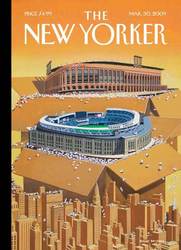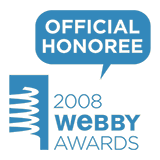Emdashes—Modern Times Between the Lines
The Basics:
About Emdashes | Email us
Ask the Librarians
Best of Emdashes: Hit Parade
A Web Comic: The Wavy Rule
Features & Columns:
Headline Shooter
On the Spot
Looked Into
Sempé Fi: Cover Art
Sempé Fi (On Covers): Base of Operations
Filed under: Sempé Fi Tagged: baseball, Bruce McCall, covers, Mets, New York City, Pollux, Yankees

Pollux writes:
In the 13th century, when all of Europe’s cities were competing with one another to build taller and grander cathedrals, we find an interesting historical figure in the form of Henri de Dreux, Archbishop of Reims. Henri’s archrival was the Bishop of Amiens, and they were both ambitiously expanding and rebuilding their respective city’s cathedrals. Henri assured his place in posterity by adding his own image to one of the stained glass windows.
And he made sure that Reims Cathedral could be all that it could be: after completing an entry porch, he quickly had it demolished and then rebuilt when he learned that his rival’s entry porch was better. These kinds of things mattered. The entry porch was, after all, a point of access for worshipers into the main structure.
These days cities in America strive to build bigger and better stadiums and sports venues, “cathedrals of baseball” involving millions of dollars, much political maneuvering, and Barnum-like hoopla. And we have two such cathedrals depicted on the cover of The New Yorker for the March 30, 2009 issue. The cover is called “Opening Day,” and the artist is Bruce McCall, who has a knack for creating images that juxtapose reality with a touch of the surreal.
Baseball is of course not necessarily the religion of America. The religion of America is religion. However, in a way, baseball stadiums truly do function in the same manner as cathedrals, with the very geographic centrality of their locations within the city, their hallowed traditions, and their crowds of worshipers. And instead of stained glass windows depicting saints and bishops, you have 39-foot banners of Babe Ruth and Lou Gehrig in the Great Hall of the new Yankee Stadium.
Whether New Yorkers like it or not, they have recently received two brand-new stadiums. The new Yankee Stadium opened on April 3, 2009, and carries a price-tag of $1.5 billion. It’s sixty-three percent larger than the old Yankee Stadium, has improved sight lines from the seats, as well as a martini bar, art gallery, private luxury suites, and, according to the Relocation Guide, “more restrooms, including family-style restrooms … providing greater convenience and more choices for all fans.” April 3 also marked another occasion: the Mets played their first game at their new stadium, Citi Field, which carries a slightly more modest price tag ($850 million).
The stadiums have not been built without controversy or criticism. For one thing, the construction of the new Yankee Stadium entailed the annexation of much-needed parkland in the city, green areas that were snatched without the benefit of a public hearing or referendum. The high costs have also been an issue. As Rick Morrissey rightly asks, “Is anyone creeped out by the money spent on this place while the nation is in the middle of serious financial difficulties?”
In the meantime, Citi Field was built amidst a controversy over the naming rights to the park, with Citigroup’s plan to pay $20 million a year for naming rights, unbelievable in light of the fact that the company, burdened by financial woes, has received $45 billion in taxpayer funds (Two New York City Council members have suggested renaming the stadium “Citi/Taxpayer Field.”). That $20 million could of course go towards reopening a hospital or fixing the plumbing in a leaky, overcrowded school, but that would just be namby-pamby socialist thinking.
Bruce McCall’s cover gleams with the color of gold, while the city below, dwarfed by the two enormous stadiums, appears weak and fragile, an elaborate collection of brittle buildings almost washed out by the brightness of doubloons. McCall’s New York City is the color of sand, as if it were a sort of American Abu Simbel, dry and devoid of trees (377 mature oak trees were in fact sacrificed in order to build the new Yankee Stadium).
The city is lifeless and threatened by the sheer scale of its new prestige architecture. It is significant to note that Henri, the Archbishop of Reims, taxed the population so heavily that he provoked a revolt in 1233 in which his archiepiscopal palace was attacked and the pope and the King of France were forced to intervene to calm the situation down.
It’s also significant to note that Bruce McCall’s illustration depicts no cheering citizens, no crowds of appreciative fans and fanfare. The two behemoth-sized boxes have been plunked down as if from a stern celestial being amidst the diminutive skyscrapers of New York. There has no discussion, no dialogue. A messy form of precipitation in the form of foam peanuts drops from the boxes like dandruff from a giant’s scalp, littering the city with Styrofoam.
McCall’s book, The Last Dream-o-Rama, attacked and lampooned the Detroit auto industry by depicting the cars the city “forgot to build” during the boom years of the 1950s and 60s. Each page contains an automobile more ridiculous than the last. “The automobile was no longer just an appliance,” McCall has remarked, “but a rolling boudoir, a metal mistress, a leather-clad dominatrix with great big pointed silver bumpers. And the industry’s leaders had the vision to follow the mob.”
I feel the same anger emanating from McCall’s “Opening Day” cover. The new stadiums are undoubtedly impressive and beautiful in their own way, as his satirical dream-cars are, but, like his Quizfire 5000 Jackpot, his Nixoneer Squelchchoramic or his 1954 Redscare Phantom Witchhunter, they seem to reek of materialism, crassness, excess, and pharaonic arrogance. The introduction to the Yankee Stadium Relocation Guide was entitled “A Fabled Stadium Inspires the Future”. Let’s hope that the future is inspired by more than that.




Comments
Spot on. A few random associations: I’ve been a baseball fan — indeed, a Yankee fan — all my life, but I find nothing here to disagree with. Did you notice that the first words of that Relocation Guide after the title page are ‘The Cathedral of Baseball”…? The word “extortion” is routinely used to describe the negotations between cities and municipalities over stadium construction. I notice that Steinbrenner admitted a couple of days ago that the ticket prices are too high….
Oh, and last thing: I bought one of those overpriced tickets a few days ago.
Thanks, Martin. How much were those overpriced tickets, if you don’t mind me asking? Did you find that the whole experience was much improved? For example, the new sight lines, etc.?
I think the prices are roughly twice as expensive, in the moderate range that most people will be interested in. The tickets that used to be $30 are now about $60 — referring to fairly well-positioned upper deck seats.
The first official game at the Stadium is next week, so I don’t know yet! My tickets are for May.
It’s a good thing I only follow women’s field hockey.